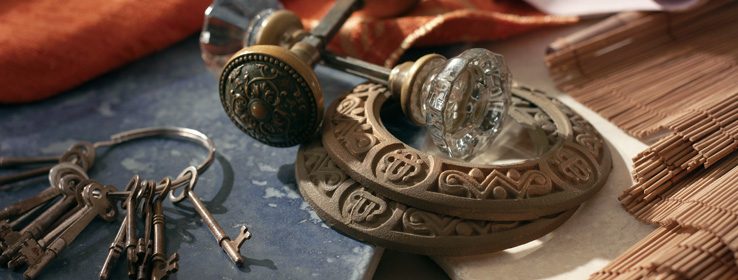Designers can promote sustainability right in their backyards by supporting regional artisans, using indigenous materials and restoring found objects.
There are thousands of resources available to help us conserve electricity and water, implement alternative energy, select nontoxic materials, and more. In fact, the myriad of choices can make going green seem fairly complicated. One way to simplify sustainability is to stick with what you know: your local area. In fact, many green advocates would say going local is what going green is truly all about. "By using indigenous products, you get a more interesting space that signifies what's available in your area," says Marcia Connors, an interior designer near Boston. "It makes a home that much more special."
Consider it a grassroots movement at its best – supporting local artists and purchasing materials from your area not only enhances a design, but also the community. Here, Connors suggests some of the ways people can go local to go green.
Find locally grown wood, if at all possible.
Bamboo has been the shining star of the sustainability movement, thanks to its relatively quick reharvest rates. However, if that bamboo happens to come from Asia, the amount of fossil fuels being burned to transport the material may weaken its green profile. If it's difficult to find flooring in your area to recycle and restore, Connors recommends asking the local lumber yard if it carries products created from indigenous trees. "I also like to ask if the lumber is coming from land that is being reforested," she adds. "You want to work with a company that really cares about replanting the trees on a cycle."
Patronize local artisans.
"If your area is known for any kind of particular artwork or culture, it would be worth examining to see if there is a way to incorporate that into a project," Connors says. For example, she recommends seeking out Native American artisans in the area. "You usually think of that as part of the Southwest, but there were tribes all over the country that have a lot of artists who do beautiful work." In addition, if you can find local artists who create art out of recycled or salvaged materials, your green quotient skyrockets. A little research into your region's history and culture – past and current – may yield a wealth of accessories, art and furnishings.
Look into deconstruction or architectural salvage shops.
Thanks to the modern green movement, deconstruction companies are more in demand than ever. If a home or another building is being razed to make room for a new structure, deconstruction workers will be called in to carefully disassemble the facility, thus significantly reducing the amount of construction waste heading to the landfill.
Many times, deconstruction companies will sell the items they've retained; lumber, windows, stained glass, trim and doors are popular products for sale. Architectural salvage shops operate similarly but are more likely to offer fireplace mantels or unique tiles. "If you can get flooring that comes from a local bank, school or house that's being demolished, you'll have something really beautiful because it's from your area," Connors notes. "And you will be recycling, reusing and bringing something with character back to its best."
Peruse garage sales, estate sales, antique stores and flea markets for accessories.
A keen eye can find a potential gem amid seemingly unusable items. In fact, restoration is one of the easiest ways to go green while introducing a unique piece into your design. If you plan to refinish furniture, for instance, use an upholsterer in your town – and request that he or she use recycled fabric for the project.
For more information:
Building with Reclaimed Components and Materials: A Design Handbook for Reuse and Recycling by Bill Addis. (Earthscan Publications Ltd., April 2006)
There are thousands of resources available to help us conserve electricity and water, implement alternative energy, select nontoxic materials, and more. In fact, the myriad of choices can make going green seem fairly complicated. One way to simplify sustainability is to stick with what you know: your local area. In fact, many green advocates would say going local is what going green is truly all about. "By using indigenous products, you get a more interesting space that signifies what's available in your area," says Marcia Connors, an interior designer near Boston. "It makes a home that much more special."
Consider it a grassroots movement at its best – supporting local artists and purchasing materials from your area not only enhances a design, but also the community. Here, Connors suggests some of the ways people can go local to go green.
Find locally grown wood, if at all possible.
Find locally grown wood, if at all possible. Bamboo has been the shining star of the sustainability movement, thanks to its relatively quick reharvest rates. However, if that bamboo happens to come from Asia, the amount of fossil fuels being burned to transport the material may weaken its green profile. If it's difficult to find flooring in your area to recycle and restore, Connors recommends asking the local lumber yard if it carries products created from indigenous trees. "I also like to ask if the lumber is coming from land that is being reforested," she adds. "You want to work with a company that really cares about replanting the trees on a cycle."
Patronize local artisans.
Patronize local artisans. "If your area is known for any kind of particular artwork or culture, it would be worth examining to see if there is a way to incorporate that into a project," Connors says. For example, she recommends seeking out Native American artisans in the area. "You usually think of that as part of the Southwest, but there were tribes all over the country that have a lot of artists who do beautiful work." In addition, if you can find local artists who create art out of recycled or salvaged materials, your green quotient skyrockets. A little research into your region's history and culture – past and current – may yield a wealth of accessories, art and furnishings.
Look into deconstruction or architectural salvage shops.
Look into deconstruction or architectural salvage shops. Thanks to the modern green movement, deconstruction companies are more in demand than ever. If a home or another building is being razed to make room for a new structure, deconstruction workers will be called in to carefully disassemble the facility, thus significantly reducing the amount of construction waste heading to the landfill.
Many times, deconstruction companies will sell the items they've retained; lumber, windows, stained glass, trim and doors are popular products for sale. Architectural salvage shops operate similarly but are more likely to offer fireplace mantels or unique tiles. "If you can get flooring that comes from a local bank, school or house that's being demolished, you'll have something really beautiful because it's from your area," Connors notes. "And you will be recycling, reusing and bringing something with character back to its best."
Peruse garage sales, estate sales, antique stores and flea markets for accessories.
Peruse garage sales, estate sales, antique stores and flea markets for accessories. A keen eye can find a potential gem amid seemingly unusable items. In fact, restoration is one of the easiest ways to go green while introducing a unique piece into your design. If you plan to refinish furniture, for instance, use an upholsterer in your town – and request that he or she use recycled fabric for the project.
For more information:
Building with Reclaimed Components and Materials: A Design Handbook for Reuse and Recycling by Bill Addis. (Earthscan Publications Ltd., April 2006)







